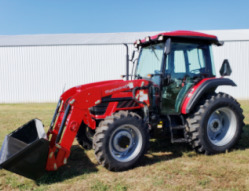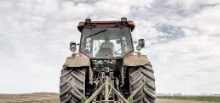________________________________________________________________________________________
| Home / Farm Tractors / Mahindra Tractors / Mahindra 6075 |
Mahindra 6075 Troubleshooting
 The
Mahindra 6075 is a 4-wheel drive utility tractor from 6000 Series. This model
was manufactured from 2018 to 2023. The components of Mahindra 6075 powerline
system: a 161.6 cubic inches (2.6 L) 4-cycle 3-cylinder direct injection
turbocharged intercooled diesel engine with a rated power of 71 Hp (53 kW), and
power shuttle transmission with 15 forward and 15 reverse gears. The maximum
travel speed (forward/reverse): 24.8 mph (39.7 km/h) and 24 mph (38.4 km/h).
The
Mahindra 6075 is a 4-wheel drive utility tractor from 6000 Series. This model
was manufactured from 2018 to 2023. The components of Mahindra 6075 powerline
system: a 161.6 cubic inches (2.6 L) 4-cycle 3-cylinder direct injection
turbocharged intercooled diesel engine with a rated power of 71 Hp (53 kW), and
power shuttle transmission with 15 forward and 15 reverse gears. The maximum
travel speed (forward/reverse): 24.8 mph (39.7 km/h) and 24 mph (38.4 km/h).
The open center hydraulic system includes a gear pump with rated fluid flow of 11.1 gal/min (42 l/min). The Mahindra 6075 is equipped with a hydrostatic power steering system, wet disc brakes, 11.2x24 (AG) or 12.5/80x18 (Industrial) front tyres, and 16.9x30 (AG) or 19.5x24 (Industrial) rear tyres. The wheelbase is 87.4 inches (2220 mm). The tractor is compatible with Mahindra 6075CL front end-loader with a max lift height of 133" (3370 mm), and Mahindra 65B backhoe with max digging depth of 112" (2840 mm).
| Engine Troubleshooting |
| Engine starts hard or will not start |
There is air in the fuel system - Bleed the system.
Clogged fuel filter - Clean or replace the filter.
Fuel injection nozzles are clogged or faulty - If necessary, replace with a new nozzle.
Water in the fuel system - Change fuel and repair fuel system.
Excessive valve clearance - Check and adjust.
Defective fuel injection pump - Change or repair the pump.
| Engine starts but then stalls |
Clogged air filter element - Air filter maintenance required.
Dirty fuel filter - Clean or replace the filter.
Poor fuel injection pump tightness - Look for any leaks of fuel pump Tighten it fast.
Fuel injectors are dirty or defective - Replace or clean fuel injectors.
Fuel injection pump malfunctioning - Repair or install a new fuel pump.
| Engine stalls after running |
Engine has not warmed up to the recommended temperature - Normalize the temperature by warming up the engine.
Dirty fuel filter - Change filter element.
Air in the fuel lines - Bleed the fuel lines.
Fuel injection nozzles fault - Test injection nozzles and change if necessary.
Fuel injection pump timing is wrong - Check the fuel injection pump timing adjustment.
| Engine stalls when idling |
Wrong adjustment of low idle speed - Correct the settings.
Fuel injection pump is faulty - Replacement or repair required.
Clogged or defective injectors - Test and replace fuel injectors if necessary.
Valve out of adjustment - Adjustment procedure required.
| Reduced engine power |
Clogged air cleaner - Air filter maintenance required.
Fuel injection nozzles are faulty or clogged - Test injection nozzles and change if necessary.
Fuel injection pressure is wrong - Correct the pressure settings.
Excessive valve clearance - Correct valve clearance needs to be set.
Low idle speed setting is not correct - Normalize low idle speed.
Restricted fuel hoses or lines - Clean fuel system hoses and lines.
Cylinder head gasket is damaged - Install a new gasket.
Leaking or defective piston rings - Replace piston rings.
| Engine is overheated |
Low coolant level - Top up coolant fluid and check system for leaks.
Engine oil level is low - Fill the crankcase with engine oil.
Faulty radiator cap or dirty radiator fins - Change cap or clean radiator.
Fan belt slipping or worn - Belt replacement is recommended.
Diesel engine is overloaded - Load reducing is recommended.
| Oil pressure too low |
Oil level is insufficient - Add oil as required.
Oil filter clogged - Change or clean engine oil filter element.
Wrong oil viscosity - Use proper viscosity oil.
Excessive crankshaft bearing oil clearance - Replace bearings.
Oil pump failure - Check and replace if necessary.
| Engine knocks or noises |
Lack of engine oil - Fill the crankcase with engine oil.
Low coolant temperature - Warm up to required temperature.
Incorrect adjustment of fuel injection pump timing - Use the correct fuel injection pump timing adjustment.
Incorrectly set low idle speed - Correct low idle adjustment.
Clogged or defective injectors - Replace or clean fuel injectors.
Connecting rod is worn or not aligned - Align or change connecting rod.
Worn or broken pistons - Replace the pistons as required.
| Transmission Troubleshooting |
| Lack of transmission oil pressure |
Transmission oil insufficient - Fill the transmission housing with oil.
Transmission oil filter is dirty (if equipped) - Service or change transmission oil filter.
Relief valve is damaged - Install a new valve.
| Transmission is excessively noisy |
Insufficient transmission oil - Check and refill the transmission oil.
Transmission oil is contaminated - Transmission oil change required.
Incorrect backlash or gears are worn - Install new gears and set backlash correctly.
Bearings are broken or worn - Change faulty bearings.
Damaged or worn gear shift forks - Change the shift forks.
Shaft splines are stuck or worn out - Replace the shaft.
| Hard shifts |
Gear shift linkage is rusty or worn - Install a new gear shift linkage.
Worn or bent shift forks - Change defective shift forks.
Gearshift mechanism is damaged - Replace or repair the mechanism.
Malfunction or incorrect clutch adjustment - Change or adjust clutch.
| Transmission oil leaking |
Too much fluid in transmission - Excess fluid must be drained.
Damaged gaskets or seals - Gaskets or seal need to be replaced.
| Hydraulics Troubleshooting |
| Hydraulic fluid pressure is insufficient |
Insufficient hydraulic fluid - Checking hydraulic fluid level and add if necessary.
Dirty hydraulic fluid filter element - Clean or change hydraulic filter.
Defective hydraulic pump - Change or repair hydraulic fluid pump.
Incorrect setting hydraulic control valve block - Set correctly.
Hydraulic cylinder is faulty - Repair or change hydraulic cylinder.
Leaking hydraulic lines - Inspect the system for leaks and fix it.
| Hydraulic system overheated |
Faulty main relief valve - Replace relief valve.
Incorrect hydraulic oil type - Use the correct type of hydraulic oil.
Hydraulic oil is dirty - Hydraulic oil change required.
Air trapped in hydraulic system - Bleed air from system.
| Hitch not raising or hitch raises slowly |
Excessive load on hitch - Reduce loading.
Hydraulic oil level low - Need to add oil.
Dirty hydraulic oil filter element - Install a new hydraulic filter element.
Hydraulic pump malfunction - Change or repair hydraulic oil pump.
Faulty main relief valve - Install a new relief valve.
Damaged hydraulic control valve - Repair or change hydraulic valve.
Faulty hydraulic cylinder - Repair or install a new hydraulic cylinder.
Suction pipe is disconnected or broken - Connect or replace pipe.
| Hitch fails to drop or drops slowly |
Hydraulic control valve block is set improperly - Set properly.
Broken hydraulic cylinder - Repair or change hydraulic cylinder.
The hitch has not been adjusted - The 3-point hitch must be adjusted.
Worn lift arm shaft - Change the shaft.
| Hitch lifting or lowering is jerky |
Air in hydraulic lines - Bleed hydraulic lines.
Dirty hydraulic fluid - The fluid must be changed.
Faulty hydraulic pump - Repair or replace hydraulic oil pump.
Hydraulic control valve block is defective - Repair or replace hydraulic valve.
Faulty hydraulic cylinder - Replace or repair hydraulic cylinder.
| Steering System Troubleshooting |
| Steering wheel turns hard |
Incorrectly assembled or damaged steering column - Reassemble the steering column correctly or change it.
Air trapped inside steering system - Bleed air.
Improper toe-in - Adjust toe-in wheels.
Uneven tyre pressure - Inflate the tyres properly.
Steering pump stopped working - Install a new hydraulic steering pump.
Pump flow control valve is worn or stuck - Service or change control valve.
Steering oil level is insufficient - Checking steering oil level and add it if necessary.
| Excessive play in steering |
Steering column coupling or shaft is extremely worn out - Replace faulty part.
Hydraulic steering pump is defective - Repair or change steering pump.
Steering linkage joints are worn or loose - Inspect and replace as required.
| Tractor is pulling to right or left |
Uneven wear on front tyres - Replace the tyres.
Not adjusted toe-in - Adjust toe-in properly.
Steering linkage components are loose or worn - Repair or replace steering linkage.
Improperly adjusted or defective front wheel bearings - Install new bearings or adjust it correctly.
| Electrical System Troubleshooting |
| Battery will not charge |
Loose or corroded wire connections - Tighten or service connections.
Electrical terminal connectors are defective - Terminal connectors need to be changed.
Battery is defective - Replace the battery.
Belt is damaged or loose - Adjust belt tension or change the belt.
| Starter turning slow |
Battery voltage is low - Battery is drained, charge it.
Battery discharges quickly - Battery needs service or replacement.
Wires are disconnected or battery terminals are corroded - Connect wires properly or change terminals.
| Starter is not working |
Battery is discharged or defective - Recharge or replace battery.
Battery wiring is disconnected or improperly connected - Inspect wiring and connect as required.
Low battery output - Battery is drained, charge it.
Defective starter motor - Repair or install a new starter.
________________________________________________________________________________________
________________________________________________________________________________________
| Farm Tractors Technical Specifications |
